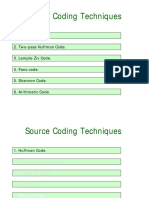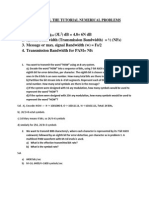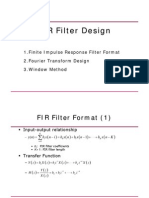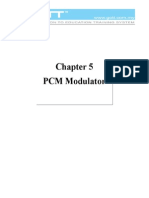0 ratings0% found this document useful (0 votes)
152 viewsCS
Uploaded by
elangocsCopyright
© Attribution Non-Commercial (BY-NC)
Available Formats
Download as PDF, TXT or read online on Scribd
0 ratings0% found this document useful (0 votes)
152 viewsCS
Uploaded by
elangocsCopyright
© Attribution Non-Commercial (BY-NC)
Available Formats
Download as PDF, TXT or read online on Scribd
You are on page 1/ 24
. me
a Qovrsdo
B.E/B.TECH, (PART-TIMR), DEGREE EXAMINATIONS — APRIL / MAY 2006
Ill SEMESTER
ELECTRICAL AND ELECTRONICS ENGINEERING
PTEE 282 - CONTROL SYSTEMS
Time: 3 Hrs. . Max, Marks = 100
ANSWER ALL QUESTIONS
PART A( 10X2= 20)
1. What are the limitations of transfer function approach ?
2. A system when excited by unit step type of input gives following response
: Cit) = 1-2e+ 4e™
Obtain its transfer function C(s) / R(s)
Draw the torque-speed characteristics of a two, phase A.C. servo motor.
With neat sketch, explain time domain specifications,
Determine the phase margin for GH = 2(§ +4) /'s? .
Explain the procedure of obtaining the value of K for specified damping ratio 8 from the
root locus, 5
What is resonant peak and resonant frequency, explain ?
State Nyquist Stabily Criterion, .
What are M & N circies 7 How are they useful in determining stability of the system?
0. Derive the transfer functions of lead network.
Parnes
PART B (5X 16 = 80). eens
11. The open loop transfer function of a unity feedback system is given by
G(s) = 1/ s(st1) (0.5s+1)
is desired to compensate the system so that the static velocity error constant Ky is
5 sec’', the phase margin Is atleast 40°” and the gain margin is atleast 10dB, Use a lag
compensator = =
12/ a) Convert the Block diagram shown in Fig.12(a) into a signal flow graph. Use
Mason's rule to find ‘C(s) / R(s) el
O
b)
18. Derive an expression for
system that is subjected tc
the transient response of a s
10 a unit step input. Obtain peak ti
fecond order undefdamped.
ime ancl wel overshoot,
(OR) .
b) A tracking servo with a unit feedback has
(8) = 10K / [s(25+1) (0.541) (O.1se1y) ‘
I the permissible velocity
error is 1° for steadystate velocity of 10 rad/ sec,
determine the value. of K,
14 2)-Dravi the gain frequency and phase frequenty plots (Bode Plot ) of » system having
* loop transfer function” > “
GH (s ) = 10 (943) / s(s+2) (s? 4451400) ;
Show both asymptotic and actual dB log and phase plots.
: : (oR) es ~ *
b)The open loop transfer function of a unit feedback system is . a
G(s) = K/ $(1+0.02s)(1+0. 04s) 5
If the gain K produces.a phase margin of 48°, what is the corresponding gain . margin
in dB? ; .
16 a) Aunit feedback system has loop transfer function
GHGS) = 10/ [(s-4)(s#2)} +
Show Nyquist Path and draw Nyquist plot. Use Nyquist criterion to determine its open:
loop and closed loop stability. “oe
(OR)
ntrol system is G(s) = K/ g(s? +4548),
vstem on 8 graph paper, touching the following points
tof The open loop transfer functiomof a ce
‘Sketch the root loci of the s\
|) . No.of root loc!
i) No. of symptotes
il) Angte of Asymptotes
Iv) Angle of departure.
v) Imaginary axis interéept,
vi) Real axis part of root locus.
and their real axis intercept
CEG (A) 103
B.E. (Part ~Time) DEGREE EXAMINATION,
NOVEMBER/DECEMBER ee
Third Semester
Bloctrical and Electronics Engineoring
PTEE 282 —. CONTROL SYSTEMS
(Regulation 2005)
‘Time : Three hours z Maxirnum : 100 marks
Answer ALL questions.
PART A—(10 x 2= 20 marks)
1. Consider the given electric network equation; draw @ signal flow graph to
dopict the equations. :
1166) «VCs YRa) ={Va(e Rad
Ma(s)/8Cs) -(1260/20a)
(5) « [V2(sYRal -[Vo(s Ral
2, Write the transfer function of the Lag-network givon in the Fig.1.
Ri
_ I | . Ry |
a) aan %
Ve | i)
. 3, Whatis the significance of Breakaway points in the plot of Root locus?
Distinguish the terms lag and lead compensators,
5. Can we use RH criterion for determining relative stability? Explain,
6. Explain the relationship between gain! margin and the damping coefficient,
7, Write down relationship between overshoot and damping coefficient.
9.
10.
1
12.
What ore M & N circles? Where do we use them?
State Nyquist's stability criterion for a open loop stable system’ to be closed
loop stable.
Explain how Bode’s plot can be used for system identification,
PART B — (6 x 16 = 80 marks)
(a) Where do we usé lag compensators? Explain the procedure for design of
lag compensators, @)
(b) Design a phase lag network for a system having G(s) «290 to have
‘Sh+0.46)
phase margin of 30°. . (8)
(a) Explain the rules used for reducing the blocks. For the system shown in
figure 12 a, obtain tlie equivalént trensfer function using block diagram
reduction methods.
ogg thh :
rt we
i Figure 12.
Or
(b) ° Find the outputs of the systeme, whose Signal Flow Graph is shown in.
Figure 12b. :.
2 CEG (A) 103
18. (a) ("Derive @ relationship the obtain the step reeponse of a typical
second order system whose closed loop trensfer function ie given by,
2
G(s)=—
if 8 4250,0008
(6)
Gi Determine the % overshoot and the timne to reach’ peak overshoot for
the system shown in figure 13 a. when a unit step input is applied,
pent
. 100 Cs)
A S74 128,
Figure 13 a. se
(on .
(by G)* | What are error constanté? Define. (4)
ii), {he open-loop trarisfer function of u unity feedback system is given
y
(5 +316)
Hon A Be HOBY
Determine the type and order of the system. Find the orror
coefficients and the steady state errors corresponding to it, (12)
14 (8) Obtain the Nyquist plot of the system with open-loop transfer function,
lids
GUS) HS = a Haas)
and also check the stability of the system. Also determine the phase and
gain margin,
Or
{D Obtain the Bode’s plot for the following system, Dotermine the systom
bandwidth atid phase and gain margins,
90(1+5)
Gs)=. :
7 (L+4s)(s? +6548) s
8 CEG (A) 103
(a)
(b)
@
Gi)
@
Gy
State and prove any two rules used for obtaining the root locus of «
given system. 6)
Consider a system whose open loop gain is givan by Gene
or
Draw the root locus and determine the value of « at which the roct,
locus intersects the imaginary axis, (10)
Or
Explain. how Routh-Hurwitz's criterion can be applied for
anelyzing the roots of characteristic equation. “6
Analyno the nature of roots of F(e) where F(s) ie given by. .
F(¢)ns4 +65" 41194620, . (20)
—_—
5 CHG (A) 108
B.E. (Part-Time) DEGREE EXAMINATION, APRIL/MAY 2007,
: ‘Third Semester
PTEE 282 — CONTROL SYSTEMS
(Regulation 2005)
‘Time : Three hours Maximum : 100 marks
Answer ALL questions.
PART A ~ (10 x 2 = 20 marks)
“\ State the merits and demerits of applying closed loop control for systems,
&Siate the merits and demerits of applying Transfer function approach to
system analysis.
\ :
\ What is position error constant? Where do we use it?
oj/ 4Rame three performance specifications in time domain,
5/ How do we apply correction in asymptote Bode's plots to obtain the exact plat.
6. What are all pass systems?
\ State the relationship between phase margin and damping ratio in a typical
second order system. !
ne an are breakaway points? Explain.
\ 9. Realise the electrical network that can provide lead compensation.
10, State Nyquist’ stability criterion fer elosed loop stability.
“ _
PART B —(5 x 16 = 80 marks) DP oadeeeeaacencane
Pa BL(i) State the rules for plotting the Root locus. ” (8)
Gi) Consider the system whose open loop transfer function is given by
. (+) ;
4 Gls)=K. Gr10je+50)" Obtain the root loci for various values of K.
+. Determine the values.of K that resuits in repeated roots. (8)
12. (a) Write short notes ‘on the following'control system components
(i) Encoders and resolvers.
(ii) Electromechanical actuators,
Or
wy ws: State and Explain the Blok diagrain reduction rules: @)
Détermine the’ loop transfer function for the system shown in
Figure. 12 (b) (i) using either block diagram reduction or signal low.
* graph techniqu —
aph techniqu
Ay
Figure 12(bXi)
eh cote a aystem whose closed loop transfer function is given by
5 a
0) = Gryes78) aX
Dust the following from the unit step response of the system,
GY Sjeady state error.
ee overshoot. ¢ ge ¢
ime constant, ——~9
ww fn alk time. wae
a Integral square error,
\ Or :
eae)
16)
2 AU-UD-1128
(b) Consider a system whose closed loop transfer function is given by,
5
5s +5,
Determine the following from the frequency response of the system
G(s)
(i) Resonant frequency.
(ii) ' Resonant peak.
(ii) DC gain.
(iv) Bandwidth. (16)
14, (a) Obtain the Nyquist’s contour of the system whose open loop transfer
function is given by G(s with, ereplaced by ¢ #1, Assess
et
se-D6+5)
the stability of the newly formed G(s) under unity negative feedback.
(16)
7 Or
w%onsiter ihe system whose open loop transfer function is given by
10
Gi
ol. ) (s-2)(e +5)
2? ‘Assess the stability of the closed loop system uhder unity negative
(10)
feedback using Routh’s Herwitz Criterion. ,
— Gipv’ What is the effect of replacing s_vith 2.43 in the Routh's Table?
6)
Explain.
a) (i) Explain the design of, lag-compensator’ for improving the steady
state performance of'alinear time invariant system. (8)
(ii) Design a suitable compensator for the system. whose open loop
transfer function is given by G(s)= to satisfy the
—
(eeie+6)
following specifications Kv 26, overshoot $5% and time constant
is lesa than 1 sec. @)
5 or
G a Ue re short notes on the following :
XY © (| Mand N Circles. @)
LO.
a
Use of signal flow graph and Mason's gain formula, (8)
Yas gra }ers)
G rd
o't3s*+as*8aat 2 Fie
ot
+OS*HIE ES
‘ @
wine (2Lole[s] slelo Ty]
BE (Part Time) End Semester DEGREE EXAMINATION, OCT / NOV 2097
‘Third Semester
Elécuical and Electronics Engineering
PTEE 235 / PTEE 282 - CONTROL SYSTEM
(Regulation 2002 / 2005)
Time : 3 Hours Answer ALL Questions: Max. Marks 100
‘ PART-A (10x 2=20 Marks)
&© Distinguish berwéen linéar and nonlinear systems.
2.- List out the basic properties of signal flow graph,
3. Drawa block diagram representation of MIMO closed loop system.
#. Define settling time and peak overshoot.
5.” Why derivative conwrdller is not used in control systems. ,
¥
& What are frequency domain specifications?
7. Brief on all pass systems
8° Define Nyquist stability criterion.
9¢ How to find the eressing poiat «i fdot locus in imaginary axis.
‘We Drawg.a neat circuit diagram ofa Ih
vad network.
® ’ he .
PART B~(5 x 16= 80 marks) us :
1 @ Write the differential equations governin
g the mechanical system shown in fig 1.
Draw the force voltage and force current
analogous circuits, ®
LLL LL OP yg
Ty
Devs
(ii) For the system represented by the block diagram shown in fig 2. Determine C/R
- 8)
and Cx/Ry.
+3. -
12, (a) (i) Consider'the circuit shown in fig 3. Identify a set ‘of state variables and draw
the signal flow graph in terms of the state variables. (8)
Gi) From the signal flow graph write the state variable equations of the circuit and
determine the transfer function. (8)
(On)
12.(b) — Aunity feedback system ha an open loop transfer function,
“
69 =
S(s+1)(0.28+1)
Design a phase lag compensation for the system to ochjeve the following
specifications.
Ky = 8, dpm = 40°
Also compare the cross’ over frequency of the uncompensated and
compensated systems,
13, (a) (i) A unity feedback system has an open loop transfer function G(s) = 10/s(s#2)
Find the rise time, percentage overshoot, peak time and setiling time for a
x step input of 12 units. (8)
Gi) Consider a unity feedback system with a close Joop transfer function
9S (8)
% cs) Ks +b :
R@) “east
Determine the open loop ttansier function G(s). Show that the steady state error
with unit ramp input is given by (@— 19
b
“4. " 7
(On),
13(by The open loop ‘wansfer function of a unity feedback system is given by
oo 588 K@+9)
= ay =
*s(s? +4 14)
Sketch the root locus of the systema,
4 (@) Draw the Bode disyram forthe following transfer function and find the stability,
: 40149)
Os) =
“(st = 2844) (145s)
(On)
14..(b) Sketch the polar plot and find the stability
200 (s +2) 4
Gey =
10s + 100)
15¢(a) () Using Ret criteria determing the ‘locations of the rest of the characteristic
equation. k =(B) asa
2s8 4 Beh 5s! 325! ase + as44 =9
Gil) Write short notes on ®
BIBO Stability, Relative and Absolute stability
(0%)
~“(b) Sketch the Nyquist plot of .
(8 +0.25) :
OG) His) = - +. and determine the stability,
S$? #1) (640.5)
eres Api
pret Phen Me ‘
Soveny
On Oe
ato o[# [561 ]9
Roll No.
B.E, (Part Time) End Semester DEGREE EXAMINATION, APR/MAY 2008
Third Semester
Electrical and Electronics Engineering
PTEE 235 / PTEE 282 - CONTROL SYSTEMS
(Regulation 2002/2005) 2a.
Time: 3 Hours Answer ALL Questions
PART-A (10 x 2= 20 Marks)
1./Compare open loop and closed loop.
2/ State Mason's gain formula, bot : ee
3>Compare the analog quantities of mechanical litiear and rotational systeit: =
4/Define delay time.
5:/Pistinguish between type and order of @ system and give example.
6» List out the adveintages and disadvantages of frequeicy domain analy:
7. When the tansfer function is said to be non-minimum phase?
8/Draw the Bode plot of a typical lag compensator.
wArvhat is the significance of Breakaway points i
16M hat do you understand by absolute stability aid Yelative stability? ~
t Jocus plot.
Part — B (5 x 16= 80 Marks)
V1. Design a suitable compensatory network for a system, whose open loop transfer
function is given by G(s) = 20//'s (1 + 0.2s)* to have a phase margin of 45°: Check
using Bode plots of phase margin of uncompensated and compensated sysiems.
Se) a
12.8! A closed.loop system is shown in the figure, The system is to have a damping ratio
of 0.7. Determine the value of k to si fy this condition and calculate the rise time,
settling time, peak time and maximum over shoot for the value of k thus
determined. (16)
Rw 4 ccm
(OR)
19/6. The transfer function of system is given as
- Kew)
SOHO = Zap et 1657 68)
af
Sketch the root locus for K>0 and mark all the features. (6)
13. Sketch the polar plot and find the stability.
200 (s +2)
G(s) eee
. 8 (s° + 10s + 100)
(6)
(OR)
46. Draw the Bode’s plot for the following system
= 48 (8 +10)
SO = Zayas t1 Te)
Also find the relative stability indices, a6)
14. a. Sketch the Nyquist plot of
- (s+0.5)
SO HG) 8(st4) (s+ 2)
Also determine the stability. (6)
(OR)
JA. b-i, Determine the stability ofa system with characteristic equation. Determine the
number of roots that are in the right half s plane and on the jw axis.
S7+ 28° + 8s* + 20s" + 16s + 16=0 0)
ii, Explain how R-H criterion can be applied for analyzing the roots of
characteristic equation. ©
15. ai, Write the state and output equations for a system shown in fig.
Yeovy >| [oe ve
Ky Ks Ke
ty fo
(ii) Consider a linear system described by the differential equation +29 +y =u+t
Choose x1 = y and x =~ uand obtain the state model. @)
(8)
(OR)
. Determine the ratio’ Cy/Ry and C2/Ro. Also find the total output for the system
whose block diagram is shown in the fig. (16)
Re o
4 @ a os
Roll No. [ae [oly ole Gl
BE art Time) End Semester DEGREE EXAMINATION, OCT /NOV 2008
Third Semester
Electrical and Electronics Engineering
4 PTEE 235 /
~- CONTROL SYSTEM
(Regulation 2002 / 2005)
Time: 3 Hours Answer ALL Questions ‘Max. Marks 100
PART-A (10 x 2=20 Marks)
1) How feedback control systems are classified?
2) Name the analogous electrical elements in torque — current analogy for the elements
6f mechanical rotational systems.
3) ite any two properties of the signal flow graph.
4) What is the effect of addition a pole to the closed loop transfer function?
5) What is the effect of a PI controller on the system performance?
6) What is the Bode plot?
1 What is the nonminimum — plane transfer function?
8) State the Nyquist stability criterion.
9) ‘The openloop transfer function of e closed loop system is G(S) = K
s(s+2) (s+4)
Find the range of values of K for stable operation.
10) What is a lag -- lead compensator? When is it preferred?
=a)
PART B ~(5 x 16 = 80 marks)
11.4) Write the differentiat equations governing the mechanical rotational systema
shown in fig and determine the transfer function Q(ST(S).
al
oat
Gi Qbian the state model of the network shown in fig. assuming Ri = Ro = 20,
= (= 1FandL = 1H
12.4)(i)Find the transfer function C(S)/R(S) for the system shown in fig using the block
diagram reduction technique.
(OR)
4
Gy G2 £940 6) ot
54s, OH He
SS ~ [ENEMA Cyt ty Ht msg = ar Gy Co Ss,
12.b) The open loop transfer function of a type 2 unity feedback system is
: k
G@)=
(1+ 0.2s)
"Design a suitable compensator to meet the following specifications. Acceleration
© error constant kq~ 10 and phase margin pm = 30°.
13.ay(t) A unity feedback system is characterized by the open loop transfer function
1
Gs) =
s(0.4s+1) (0.15s+1)
Determine the steady state errors for unit step, unit ramp and unit - acceleration
inputs.
(iA second order system has a damping ratio of 0.7 and its natural frequency of
oscillation is 12 radians per second. Determine the damped frequency of
oscillation the rise time, peak time, peak overshoot and settling time, Also
determine the closed loop transfer function.
(OR)
13.b) Sketch the root locus for the system with
K(S#2s+10)
66) HE)
s(s+2) ”
14.a) Sketch the polar plot of the transfer function given below. Determine the
frequency at which the plot cross the real axis and the corresponding magnitude,
¥ 1
Gs)=
s(1+2s) (15s)
(OR)
14.) Sketch the Bode plot of the given transfer function
1
Gs) =
s(t) (+45)
Comment on the stability of the system.
15.a) - Sketch the Nyquist plot and deter
whose open loop transfer function is
ine the stability of the closed loop system
K (s+6)
G(s) H(s) = ~~
s(st2)
(OR)
15.bXi)Using Routh criterion, deter
following characteristic equ:
number of roots of the char
tmine the stability of the systems represented by the
tation. For systems found to be unstable, determine the
racteristic equation in the right-half of the s plane.
8? +254 94 25343924 ds 45=0 (12)
Giy Discuss in detail BIBO stability. (4)
rane
You might also like
- Feedback and Control Systems Laboratory: ECEA107L/E02/2Q2021100% (2)Feedback and Control Systems Laboratory: ECEA107L/E02/2Q202126 pages
- Quiz in Data Communications and Networking ECE Board ExamNo ratings yetQuiz in Data Communications and Networking ECE Board Exam4 pages
- Digital Communication Solved MCQs (Set-2)No ratings yetDigital Communication Solved MCQs (Set-2)5 pages
- Mega Mock Test - Analog Communication - CJ SirNo ratings yetMega Mock Test - Analog Communication - CJ Sir22 pages
- Forouzan Digital Communications and NetworkingNo ratings yetForouzan Digital Communications and Networking13 pages
- 9-Frequency Spectrum, Power relation-17-Dec-2019Material - I - 17-Dec-2019 - Extract - Pages - From - 2 PDFNo ratings yet9-Frequency Spectrum, Power relation-17-Dec-2019Material - I - 17-Dec-2019 - Extract - Pages - From - 2 PDF10 pages
- Explain The Process of Quantization and Obtain The Expression For Signal To Quantization Ratio in The Case of Uniform QuantizerNo ratings yetExplain The Process of Quantization and Obtain The Expression For Signal To Quantization Ratio in The Case of Uniform Quantizer3 pages
- Chapter 4 Digital Modulation - Part 2 - 2 - ContengNo ratings yetChapter 4 Digital Modulation - Part 2 - 2 - Conteng43 pages
- Cauchy-Euler Equation: Higher-Order Differential EquationsNo ratings yetCauchy-Euler Equation: Higher-Order Differential Equations7 pages
- Digital and Data Communication NetworksNo ratings yetDigital and Data Communication Networks49 pages
- Source Coding Techniques: 1. Huffman Code. 2. Two-Pass Huffman Code. 3. Lemple-Ziv CodeNo ratings yetSource Coding Techniques: 1. Huffman Code. 2. Two-Pass Huffman Code. 3. Lemple-Ziv Code111 pages
- Electronic Communication System, Chapter 7 AnsNo ratings yetElectronic Communication System, Chapter 7 Ans16 pages
- School of Electronics Engineering (Sense)No ratings yetSchool of Electronics Engineering (Sense)12 pages
- MCQ in Engineering Management Part 3 Engineering Board ExamNo ratings yetMCQ in Engineering Management Part 3 Engineering Board Exam17 pages
- MULTIPLE CHOICE. Choose The One Alternative That Best Completes The Statement or Answers The QuestionNo ratings yetMULTIPLE CHOICE. Choose The One Alternative That Best Completes The Statement or Answers The Question4 pages
- Digital Communication Ece 304 Assignment-1No ratings yetDigital Communication Ece 304 Assignment-19 pages
- II B. Tech II Semester II B. Tech II Semester Regular Examinations August - 2014 Control Systems 2014No ratings yetII B. Tech II Semester II B. Tech II Semester Regular Examinations August - 2014 Control Systems 20148 pages
- Feedback and Control Systems Laboratory: ECEA107L/E02/2Q2021Feedback and Control Systems Laboratory: ECEA107L/E02/2Q2021
- Quiz in Data Communications and Networking ECE Board ExamQuiz in Data Communications and Networking ECE Board Exam
- 9-Frequency Spectrum, Power relation-17-Dec-2019Material - I - 17-Dec-2019 - Extract - Pages - From - 2 PDF9-Frequency Spectrum, Power relation-17-Dec-2019Material - I - 17-Dec-2019 - Extract - Pages - From - 2 PDF
- Explain The Process of Quantization and Obtain The Expression For Signal To Quantization Ratio in The Case of Uniform QuantizerExplain The Process of Quantization and Obtain The Expression For Signal To Quantization Ratio in The Case of Uniform Quantizer
- Chapter 4 Digital Modulation - Part 2 - 2 - ContengChapter 4 Digital Modulation - Part 2 - 2 - Conteng
- Cauchy-Euler Equation: Higher-Order Differential EquationsCauchy-Euler Equation: Higher-Order Differential Equations
- Source Coding Techniques: 1. Huffman Code. 2. Two-Pass Huffman Code. 3. Lemple-Ziv CodeSource Coding Techniques: 1. Huffman Code. 2. Two-Pass Huffman Code. 3. Lemple-Ziv Code
- MCQ in Engineering Management Part 3 Engineering Board ExamMCQ in Engineering Management Part 3 Engineering Board Exam
- MULTIPLE CHOICE. Choose The One Alternative That Best Completes The Statement or Answers The QuestionMULTIPLE CHOICE. Choose The One Alternative That Best Completes The Statement or Answers The Question
- II B. Tech II Semester II B. Tech II Semester Regular Examinations August - 2014 Control Systems 2014II B. Tech II Semester II B. Tech II Semester Regular Examinations August - 2014 Control Systems 2014



























































